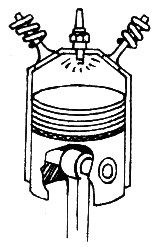Chemical potential

Chemical Potential Energy is the energy stored up in substances due to their chemical bonds. It is energy that is stored in chemicals. One example of how this plays a part in real life is through plants. The plants make energy with chemical potential energy by the process of photosynthesis. Other organisms eat the plants to get energy and so on. Energy is passed from one organism to another. This is how chemical potential energy works in the environment. Another common example is the energy stored in gasoline.[1] When the car is turned on, the chemical energy in the gas is converted into mechanical energy to move the car.[2] The law of conservation of energy says energy cannot be created or destroyed.[3] It can only be changed from one form into another.[3]
References[change | change source]
- ↑ "Forms of Energy: Motion, Heat, Light, Sound". BURN: An Energy Journal/SoundVision. Archived from the original on 19 September 2015. Retrieved 25 September 2015.
- ↑ Chris Woodford (12 December 2014). "The conservation of energy". ExplainThatStuff. Retrieved 25 September 2015.
- ↑ 3.0 3.1 "The Physics of Driving". Codman Academy Charter School. Archived from the original on 4 October 2015. Retrieved 25 September 2015.
